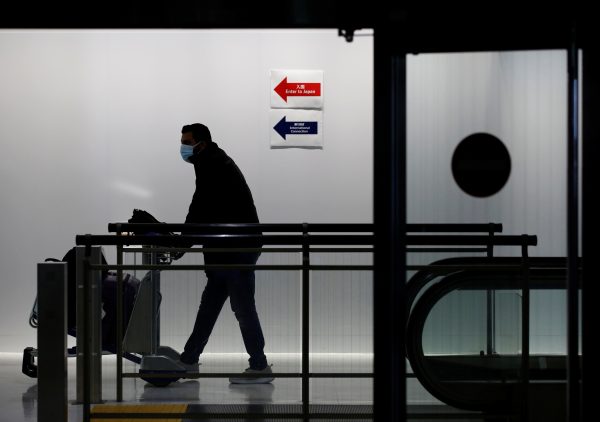On 30 November 2021, Japan re-enacted the country’s strict COVID-19 border control measures in response to the Omicron variant. It has since copped significant international flak with accusations that its border policies are ‘unscientific,’ unfairly discriminate against foreign nationals, and out of step with the industrialised democracies of the G7.
Japan had just started to re-open its doors on 8 November. With the lower house election in October out of the way and 74 per cent of the country double-jabbed, there was great optimism. When the border slammed shut, the frustrations of international students, researchers, professionals and families seeking to enter Japan were palpable.
The justifications for border restrictions amid surging infections globally are several. One was to prevent, or at least delay, Omicron from taking hold in Japan. Japan bought itself time to prepare for the coming wave. In December, Japan’s case count remained low with an average of less than 180 cases per day. In January, Japan’s sixth wave of infections started to accelerate reaching an average of over 32,000 daily infections. There was a record 102,000 cases nationally on 3 February.
The core of the international condemnation of Japan’s border policies is not its strictness, but the differential treatment of Japanese and non-Japanese nationals. Japanese nationals have been largely free to come and go from Japan. While the government continues to foot the bill for hotel quarantine for returnees from designated areas, an estimated half a million Japanese made overseas trips in 2021 without any vetting.
As Saya Soma and Yves Tiberghien explain in our lead essay this week, Japan has halted the issuance of new visas, which has ‘essentially closed the country to non-Japanese citizens’. Spouses and children of Japanese nationals, diplomats and humanitarian exceptions are considered on a case-by-case basis, but not guaranteed. For a significant portion of 2021, even long-term foreign residents of Japan with valid visas were denied re-entry.
The number of international students in Japan dropped from over 312,000 in 2019 to less than 280,000 in 2020. An ‘estimated 150,000 international students enrolled in Japanese universities as part of Japan’s engagement policy in Asia and beyond’ remain locked out, but the government has given exceptions to just 400 students.
Locked out since March 2020, postgraduate students in two-year programs taking classes online will graduate next month without having set foot in Japan. Other students — frustrated waiting for the border to open — are giving up or switching to schools in South Korea.
In a public letter, over 100 leading international Japan scholars called on Prime Minister Fumio Kishida to allow international students to enter the country subject to vaccine, testing, quarantine and other public health protocols and requirements. As they proclaim, study should not be equated with tourism and requires significant forward planning.
Japanese business leaders have also started to call on the government to ease restrictions. The head of Japan’s powerful business lobby Keidanren warned that business cannot operate on domestic strength and resources alone. Uniqlo CEO Tadashi Yanai complained that ‘new graduates of overseas colleges that we hire cannot enter Japan’. Rakuten CEO Hiroshi Mikitani equated Japan’s border policy with the sakoku (closed country) policy of the Tokugawa era (1603 to 1868).
In 2021, the number of Japan’s Technical Intern Training Program trainees — a crucial source of foreign workers — fell for the first time ever by more than 50,000 people. This contributed to labour shortages in some sectors, notably in farming.
Despite the imperatives to provide some predictability to international students, professionals and families, Kishida is unlikely to make major changes any time soon. Missteps on COVID-19 derailed the tenures of his two immediate predecessors. This included the ill-fated ‘Go To Travel’ campaign to support the tourism industry and the decision to hold the Olympics in the face of significant public opposition.
Kishida can’t risk any loss of public confidence in the lead up to the upper house elections in July 2022. If he is to have any hope of reducing his dependence on the conservative nationalist faction bosses of his ruling Liberal Democratic Party and striking his own policy course, Kishida needs a big electoral win.
Staying tough on the border is perhaps the easiest way for Kishida to demonstrate his COVID-19 credentials to the Japanese public. Easing border restrictions would risk domestic backlash given that the US military contributed to the introduction of Omicron into Japan. Introducing other more rigorous measures, such as lockdowns — by amending the Act on Special Measures for Pandemic Influenza and the Infectious Diseases Control Law — is judged to be too politically tricky, perhaps in part due to memories of the 1925 Peace Preservation Law, which was designed to quash political dissent.
Looking long term, Japan will need to find a way to recover its good graces with international students and the international community. Japan’s rapidly ageing and shrinking population means it will need increasing numbers of foreign workers in the future to keep its economy running smoothly. According to the Japan International Cooperation Agency, Japan is expected to need over 6.7 million foreign workers by 2040, about four times the current number.
Alienating international student cohorts, who are interested in learning the language and working in Japan in the future, risks doing damage to Japan’s long-term prospects.
The EAF Editorial Board is located in the Crawford School of Public Policy, College of Asia and the Pacific, The Australian National University.

